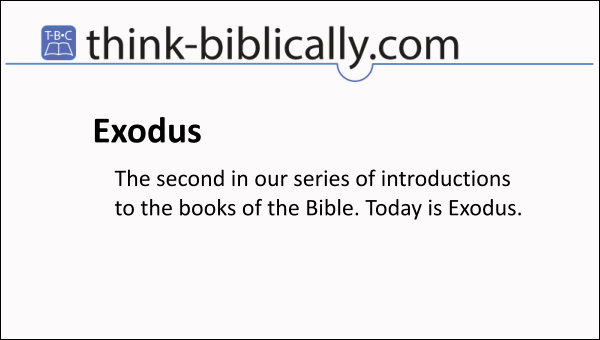By Tyson Thorne

Exodus is a continuation of Genesis. Examining Genesis 46.8 where the phrase "These are the names of the sons of Israel (Jacob and his descendants) who went to Egypt..." we find a parallel in the opening verse of Exodus (1.1), "These are the names of the sons of Israel who went to Egypt with Jacob, each with his family...". Clearly the two books belong together. The book begins listing the names of those impacted by oppression and slavery and ends with a rescued population of Israel camped out in the desert at the foot of God's Mountain.
The question Exodus leaves the reader with may be, "What are they doing there?" Instead of setting up home in the Promised Land they continue to live in an arid no man's land waiting for God's go-ahead. The purpose of their delayed satisfaction is that they, as individuals and as a nation, need to learn how to respect and relate to their God. If they are going to be successful in their new homeland, they must learn how to depend upon the Lord. As such Exodus is full of theology as God reveals more of himself to this generation of Israel than he does to most any other.
Along with establishing essential and insightful truths to God's nature and character, it also tells us of events that would help define the nation and anchor their relationship with God. The Passover, an event so striking and amazing that it is still remembered in Jewish communities today. If Genesis reveals the creation and establishment of humanity, Exodus is the creation and establishment of Israel.
Date and Authorship
Conventional historians date the Exodus during the reign of Ramses II, toward the end of the 19th dynasty (circa 1290 b.c.). In accordance with the writings of I. Velikovsky, D. Courville and D. Mackey, and evidence from the Biblical record itself, this author dates the Exodus during the reign of Amenhotep II (circa 1446 b.c.). A brief description of the scholarship behind this method of dating follows.
Back in the 1950’s the two volumes Worlds in Collision and Ages in Chaos by Immanuel Velikovsky, found a popular audience. The dates of the Third Intermediate Period (1070-712 b.c.) were cut by some 200 years. The idea was readily rejected by scholars as “absurd.”
However, while sincerely rejecting the new dating as proposed as utter nonsense, certain British historians felt there was something fundamentally wrong with the conventional chronology and produced articles accordingly. In the mid 1980’s they were joined by a number of graduate students at London’s Institute of Archaeology.
The two initiators of this movement, Peter James and David Rohl, had a falling out which resulted in two publications, Centuries of Darkness and Pharaohs and Kings. The caption for this movement is “The New Chronology” and eliminates some 350 years from ancient datings.
— Two Waves in the Sea of Scholarship, paper by Charles Cook, delivered June 19, 1997, The Ancient Records Study Group of the Egyptian Study Society, at the Denver Museum of Natural History.
For other credible research and discussion of this dating method, see also KMT Magazine, summer 1993 and KMT Magazine Winter 1995-96. While unpopular among humanist scholars, the earlier date is credible historically and archaeologically.
Biblical support for the early dating of the Exodus is three-fold. First, 1 Kings 6.1 relates there are 480 years between the Exodus and the beginning of the construction of Solomon’s temple (during the fourth year of his reign). The temple construction occurred in 966 b.c.. Subtracting 480 years from 966 b.c. and we arrive at a date of 1446 . Furthermore, indications from Judges 11.26 place the time of the Exodus sometime in the middle of the 15th century. Second, the Biblical account of the Exodus squares with archaeological evidence found in Egypt during this period. Third, historical accounts concur with the events of Palestine recorded in the Bible, including Joshua’s conquests. As the evidence continues to mount, even humanist scholars must reexamine their preconceived notions regarding the dates of the ages. These evidences and more are well laid out in the award-winning documentary, Patterns of Evidence: The Exodus (Thinking Man Films, copyright 2015).
The author of Exodus – and the rest of the Pentateuch is, of course, Moses. He even indicates in certain sections that he is the author (Exodus 17.14, 24.4, and 34.27). The New Testament authors Mark (in Mark 7.10 and 12.26) and Luke (Luke 2.22-23) seemed convinced that Moses is the author as well. Since the writing has to be after the time of the events they portray, the date of writing would likely be circa 1425 BC or later — but not much later.
The Big Idea
From among the blessed line of Abraham God brings deliverance for his people through Moses, God's chosen mediator and the one whom God will make a national covenant with, in order to establish the presence of God's kingdom among the people both in their hearts and through the Tabernacle.
Outline
I. Israel in Egypt, chapters 1-13
II. Istael in Wilderness, chapters 14-18
III. Israel at Mount Sinai, chapters 19-40
.
